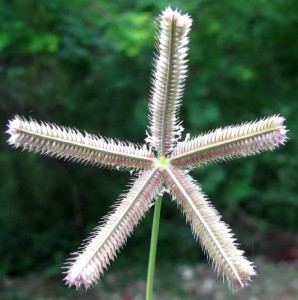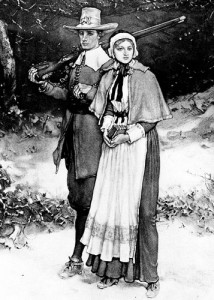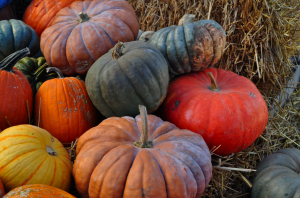From the Village Green
If you’re looking around and lamenting that the green world is turning winter brown now’s the time to find a colony of Crowfoot Grass and start harvesting. Brown is fine. You don’t want it green. I call Crowfoot Grass, Dactyloctenium aegyptium, Helicopter Grass because all of the digits are on the same plane like the blades of a helicopter, and, perpendicular to the stem just like a helicopter. While the grain is small it’s easy to collect quarts of it at a time. The seed itself is not soft but is fragile so it grinds or chews easily despite having the texture of sand. Locally look for large colonies twice a year, before the summer heat and again in the fall. It’s a staple food in Africa used to make unleavened bread and beer… Crowfoot Beer … has a certain commercial appeal don’t you think? To learn more about Crowfoot Grass click here.
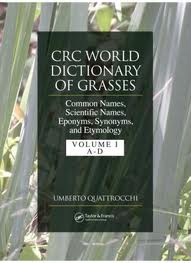 ♣ While on the topic of grasses they are a staple we forage that can be maddening to identify. If you are inclined to want to identify grasses start with one you know well and learn how it’s botanically described. No easy task. Like mushrooms grasses have a language all their own which you will see if you click on the Crowfoot Grass link above. If grass argot is not difficult enough there few books on identifying grasses and some of them are quite expensive, a $1,000 or more. (No, that is not a typo.) Fortunately one world expert has an uncommon name so you can usually access his publications on line by typing in the grass’ botanical name and his last name. That usually produces in the top few results some pages from one of his books that has that species in it. His name is Umberto Quattrocchi. Professor Quattrocchi’s books are academic and often very dense. Sometimes when you have accessed to his books on line you’ll have to scroll up or down several pages to find exactly what you are looking for.
♣ While on the topic of grasses they are a staple we forage that can be maddening to identify. If you are inclined to want to identify grasses start with one you know well and learn how it’s botanically described. No easy task. Like mushrooms grasses have a language all their own which you will see if you click on the Crowfoot Grass link above. If grass argot is not difficult enough there few books on identifying grasses and some of them are quite expensive, a $1,000 or more. (No, that is not a typo.) Fortunately one world expert has an uncommon name so you can usually access his publications on line by typing in the grass’ botanical name and his last name. That usually produces in the top few results some pages from one of his books that has that species in it. His name is Umberto Quattrocchi. Professor Quattrocchi’s books are academic and often very dense. Sometimes when you have accessed to his books on line you’ll have to scroll up or down several pages to find exactly what you are looking for.
♣ Recent uploads on the home page: Ground Ivy, Edible Flowers Part Six.
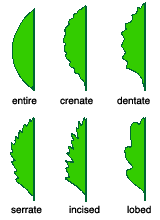 ♣ Botany Builder: Blade and Margin. Generally speaking a blade is a leaf, and the margin is the edge of the leaf. The shape of the edge is important and often it has teeth. Leaves can also be simple, that is, just one unremarkable leaf at a time. Leaves can also be compound which is branches of leaves with smaller branches of leaves and some times even with smaller branches of leaves yet again, compound, double compound and triple compound. A lot of tropical trees and or trees in the pea family have compound leaves which make them look feathery. That look is called pinnate, which is Dead Latin for feather. While this page is not yet finished — read on-going — a nice graphic on the different kinds of leaves is here.
♣ Botany Builder: Blade and Margin. Generally speaking a blade is a leaf, and the margin is the edge of the leaf. The shape of the edge is important and often it has teeth. Leaves can also be simple, that is, just one unremarkable leaf at a time. Leaves can also be compound which is branches of leaves with smaller branches of leaves and some times even with smaller branches of leaves yet again, compound, double compound and triple compound. A lot of tropical trees and or trees in the pea family have compound leaves which make them look feathery. That look is called pinnate, which is Dead Latin for feather. While this page is not yet finished — read on-going — a nice graphic on the different kinds of leaves is here.
♣ On a historical note: Now that turkey day is past the Thanksgiving pilgrims did not wear tall hats and white kerchiefs. Those were the Puritans, right, the same folks who thought buttons were a sign of vanity. They used hooks and eyes. The Pilgrims, however, wore whatever and ate whatever. They were mishmashed in appearance and diet. If it weren’t for the foraging and agricultural skills of the natives in the area the Pilgrims would not have survived. Whether they ate turkey that first thanksgiving is a matter of debate. Back then the word “turkey” meant any large fowl, so it could have been a goose. More so the culinary history of the turkey is a bit more convoluted. It was a scrawny North American bird taken to Europe where over a century or so was bred to be large and fat. Then it came back to America to be the mainstay of Thanksgiving and an icon. Yes, the archetypal symbol of the All-American holiday is a European innovation.
The Pilgrims themselves credited one native food without which they all would have perished, the pumpkin. It was the one food that made the difference that first difficult winter. Was it by chance there were pumpkins at Plymouth? Today we think of the past native population as a single people but they were not, and pumpkins were more a crop of southern tribes than of the north or even Midwest tribes. Even in the north pumpkins made it only to about Pennsylvania yet there they were in Plymouth and without which the Pilgrims would not have survived. Quite a coincidence. To read more about the Seminole Pumpkin click here.
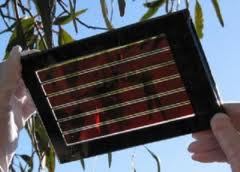 ♣ Did you know poke berry juice makes solar cells more efficient? A red dye from the berries is used to coat fiber-based solar cells. The dye absorbs and traps sunlight for a greater conversion into solar power. Fiber-based solar cells are extremely efficient usually generating twice the energy of traditional solar cells. Plastic fibers are stamped into plastic sheets very similar to the way tops are attached to soda cans. Then an “absorber” is sprayed on to the cells, in this case poke berry juice. Poke is a controversial plant, a spring time edibles doctors would ban if they could. To read more about poke click here.
♣ Did you know poke berry juice makes solar cells more efficient? A red dye from the berries is used to coat fiber-based solar cells. The dye absorbs and traps sunlight for a greater conversion into solar power. Fiber-based solar cells are extremely efficient usually generating twice the energy of traditional solar cells. Plastic fibers are stamped into plastic sheets very similar to the way tops are attached to soda cans. Then an “absorber” is sprayed on to the cells, in this case poke berry juice. Poke is a controversial plant, a spring time edibles doctors would ban if they could. To read more about poke click here.
♣ Classes this week: I am on the road with students signed up in both locations so barring injury or illness they should go on as scheduled. To sign up for a class or to learn more about them, click here.
Saturday, December 3rd, Wickham Park: 2500 Parkway Drive, Melbourne, FL 32935-2335. 9 a.m.
Sunday, December 4th, Dreher Park, 1310 Southern Blvd., West Palm Beach, 33405. 9 a.m.
♣ IN NEXT WEEK’S NEWSLETTER: Exclusive, straight talk on the Palmer Amaranth controversy.
To donate to the Green Deane Newsletter click here.

